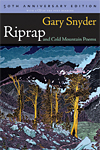 To fully appreciate poetry, it is often said, we should hear it read aloud. Better yet is hearing it read by the poet. The fiftiethanniversary edition of Gary Snyder’s “Riprap and Cold Mountain Poems” (Count e rpoint , 2009, $24.00 hardcover, 80 pp., with CD) lets us do just that. On the accompanying CD, Snyder reads the twenty-four poems with themes of nature and interconnectedness that make up “Riprap,” his first published collection, and twenty-four poems by the enigmatic seventh- or eighth-century Chinese poet Han Shan, known as “Cold Mountain,” that were Snyder’s first published translations. Minimal yet profound, both sets of poems underscore the eastern influences— notably Chan/Zen and Taoism—that mark Snyder’s work from early on. A bonus: compare Snyder’s intimate, gravelly-voiced recitation of his work now, with his more stentorian presentation when “Riprap” was first written; the CD includes him reading six of the poems at Reed College, his alma mater, in 1956.
To fully appreciate poetry, it is often said, we should hear it read aloud. Better yet is hearing it read by the poet. The fiftiethanniversary edition of Gary Snyder’s “Riprap and Cold Mountain Poems” (Count e rpoint , 2009, $24.00 hardcover, 80 pp., with CD) lets us do just that. On the accompanying CD, Snyder reads the twenty-four poems with themes of nature and interconnectedness that make up “Riprap,” his first published collection, and twenty-four poems by the enigmatic seventh- or eighth-century Chinese poet Han Shan, known as “Cold Mountain,” that were Snyder’s first published translations. Minimal yet profound, both sets of poems underscore the eastern influences— notably Chan/Zen and Taoism—that mark Snyder’s work from early on. A bonus: compare Snyder’s intimate, gravelly-voiced recitation of his work now, with his more stentorian presentation when “Riprap” was first written; the CD includes him reading six of the poems at Reed College, his alma mater, in 1956.
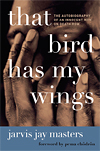 Jarvis Jay Masters became the voice of Buddhism at San Quentin with his 1997 memoir, “Finding Freedom: Writings from Death Row,” about practicing in solitary confinement at the California prison. Incarcerated since 1981—the last nineteen of those years for a prison murder there’s now evidence he didn’t commit—Masters used some of that time to write a prequel, “That Bird Has My Wings: The Autobiography of an Innocent Man on Death Row” (HarperOne, 2009, $24.99 hardcover, 304 pp.). Filling in the years up to and right after his conviction at age nineteen, it’s a harrowing tale of loss, abuse, and neglect—a bright, caring kid done in by the failings of foster care and the juvenile detention system, and ultimately, his own violence. Intended as a cautionary tale—Masters doesn’t shirk responsibility for his actions— the book also inspires. We see him reconnect with his basic kindness after he begins meditating and takes vows with Chagdud Rinpoche. His present teacher, Pema Chödrön, wrote the book’s foreword.
Jarvis Jay Masters became the voice of Buddhism at San Quentin with his 1997 memoir, “Finding Freedom: Writings from Death Row,” about practicing in solitary confinement at the California prison. Incarcerated since 1981—the last nineteen of those years for a prison murder there’s now evidence he didn’t commit—Masters used some of that time to write a prequel, “That Bird Has My Wings: The Autobiography of an Innocent Man on Death Row” (HarperOne, 2009, $24.99 hardcover, 304 pp.). Filling in the years up to and right after his conviction at age nineteen, it’s a harrowing tale of loss, abuse, and neglect—a bright, caring kid done in by the failings of foster care and the juvenile detention system, and ultimately, his own violence. Intended as a cautionary tale—Masters doesn’t shirk responsibility for his actions— the book also inspires. We see him reconnect with his basic kindness after he begins meditating and takes vows with Chagdud Rinpoche. His present teacher, Pema Chödrön, wrote the book’s foreword.
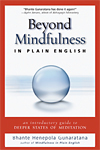 Sri Lankan monk Bhante Henepola Gunaratana—“Bhante G.” to his followers—has introduced countless people to insight meditation through his bestselling classic, “Mindfulness in Plain English,” published nearly two decades ago. Now, in “Beyond Mindfulness in Plain English: An Introductory Guide to Deeper States of Meditation” (Wisdom Publications, 2009, $15.95 paperback, 224 pp.), he leads those who have already developed a practice into the oft-confusing thicket of the jhanas—ever-subtler states of concentration, joy, and profound calm. The teachings here are accessible and the practice instructions clear. Still, there’s the nagging question of how much progress can be made with just a book for guidance. Bhante G.’s reassuring voice makes it well worth a try.
Sri Lankan monk Bhante Henepola Gunaratana—“Bhante G.” to his followers—has introduced countless people to insight meditation through his bestselling classic, “Mindfulness in Plain English,” published nearly two decades ago. Now, in “Beyond Mindfulness in Plain English: An Introductory Guide to Deeper States of Meditation” (Wisdom Publications, 2009, $15.95 paperback, 224 pp.), he leads those who have already developed a practice into the oft-confusing thicket of the jhanas—ever-subtler states of concentration, joy, and profound calm. The teachings here are accessible and the practice instructions clear. Still, there’s the nagging question of how much progress can be made with just a book for guidance. Bhante G.’s reassuring voice makes it well worth a try.
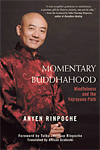 Realization doesn’t happen in an instant but unfolds gradually; momentto- moment awareness is the essential training that keeps us pointed in the right direction. Such is the message of “Momentary Buddhahood: Mindfulness and the Vajrayana Path” (Wisdom Publications, 2009, $15.95 paperback, 160 pp.). Here, in talks given during 2005–2006, a year after he came to the U.S., Dzogchen master Anyen Rinpoche—former head scholar of his monastery in Kham, Tibet—elucidates the role of mindfulness and discernment in tantric practice, as the vehicle for balancing energy and working directly with afflictions. Citing the conventional wisdom that “the path is the goal,” Anyen tells us that although “just practicing, with no attachment to outcomes, is the ultimate goal,” initially we have to be “more pragmatic… committed to cutting through our selfattachment and increasing our wisdom for the long haul.”
Realization doesn’t happen in an instant but unfolds gradually; momentto- moment awareness is the essential training that keeps us pointed in the right direction. Such is the message of “Momentary Buddhahood: Mindfulness and the Vajrayana Path” (Wisdom Publications, 2009, $15.95 paperback, 160 pp.). Here, in talks given during 2005–2006, a year after he came to the U.S., Dzogchen master Anyen Rinpoche—former head scholar of his monastery in Kham, Tibet—elucidates the role of mindfulness and discernment in tantric practice, as the vehicle for balancing energy and working directly with afflictions. Citing the conventional wisdom that “the path is the goal,” Anyen tells us that although “just practicing, with no attachment to outcomes, is the ultimate goal,” initially we have to be “more pragmatic… committed to cutting through our selfattachment and increasing our wisdom for the long haul.”
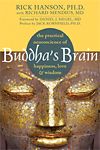 Buddhism and neuroscience seem to be in constant conversation these days. Whether we need to know the workings of the brain in order to change the mind is arguable, but the research is pretty interesting nonetheless. In “Buddha’s Brain: The Practice of Neuroscience of Happiness” (New Harbinger, 2009, $16.95 paperback, 224 pp.), Rick Hanson, a neuropsychologist and longtime Buddhist practitioner—and Tricycle book reviewer, Summer 2009 issue—has joined with neurologist Richard Mendino to provide a cram course on neuroplasticity and rewiring the brain through meditation. “You don’t need an EEG or a Ph.D. in neuroscience to observe your experience and the world, and become a happier and kinder person,” the authors admit. But if you’re too busy for traditional practice, these techniques can speed the process, they suggest. At the very least you’ll be able to follow the brain science–meditation conversation.
Buddhism and neuroscience seem to be in constant conversation these days. Whether we need to know the workings of the brain in order to change the mind is arguable, but the research is pretty interesting nonetheless. In “Buddha’s Brain: The Practice of Neuroscience of Happiness” (New Harbinger, 2009, $16.95 paperback, 224 pp.), Rick Hanson, a neuropsychologist and longtime Buddhist practitioner—and Tricycle book reviewer, Summer 2009 issue—has joined with neurologist Richard Mendino to provide a cram course on neuroplasticity and rewiring the brain through meditation. “You don’t need an EEG or a Ph.D. in neuroscience to observe your experience and the world, and become a happier and kinder person,” the authors admit. But if you’re too busy for traditional practice, these techniques can speed the process, they suggest. At the very least you’ll be able to follow the brain science–meditation conversation.
Thank you for subscribing to Tricycle! As a nonprofit, we depend on readers like you to keep Buddhist teachings and practices widely available.